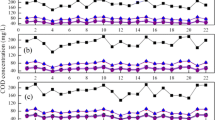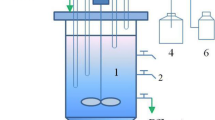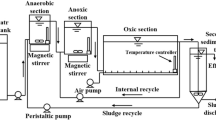Abstract
A bench-scale anaerobic–anoxic–oxic (A2O) bioreactor with steady denitrifying phosphorus removal performance was tested to determine the influence of influent C/N ratio (SCOD/TN) and C/P ratio (SCOD/TP) on biological nutrient removal for treating synthetic brewage wastewater; meanwhile, the spatial profiles of DO, pH and ORP sensors in such systems were investigated. The results showed that influent C/N ratio had significant effect on the TN, TP removal efficiencies and the ratio of anoxic to aerobic P uptake amount. The maximal TN and TP removal efficiencies could be achieved when influent C/N ratio was kept at about 7.1 and 5, respectively. Besides, the ratio of anoxic to aerobic P uptake amount was found to be linearly dependent on the influent C/N ratio with coefficient R 2 of 0.685 when total recirculation ratio was constant at 3.5. Influent C/P ratio had an important effect on the TP removal efficiency, while it hardly affected TN removal efficiency. In addition, the TP removal efficiency reached the maximum for influent C/P ratio of 42. On the other hand, it was also found that the typical profiles of DO, pH and ORP sensors could be observed, and they have similar trends at the different influent C/N ratio and C/P ratio. It was suggested that the operational state could be well known according to the changes of simple on-line sensors.






Similar content being viewed by others
Abbreviations
- A2O:
-
anaerobic–anoxic–oxic
- PAOs:
-
polyphosphate-accumulating organisms
- DNPAOs:
-
denitrifying phosphate-accumulating organisms
- BNR:
-
biological nutrient removal
- EBPR:
-
enhanced biological phosphorus removal
- PHB:
-
poly-β-hydroxybutyrate
- MCRT:
-
mean sludge retention time (days)
- HRT:
-
hydraulic retention time (h)
- UCT:
-
University of Cape Town
- MLSS:
-
mixed liquid suspended solid concentration (g/L)
- DO:
-
dissolved oxygen concentration (mg/L)
- SCOD:
-
soluble chemical oxygen demand (mg/L)
- ORP:
-
oxidation–reduction potential
- GAOs:
-
glycogen-accumulating organisms
- VFA:
-
volatile fat acid
- C/N:
-
the ratio of soluble chemical oxygen demand (SCOD) to total nitrogen (TN) for influent wastewater
- C/P:
-
the ratio of soluble chemical oxygen demand (SCOD) to total phosphorus (TP) for influent wastewater
- WWTPs:
-
wastewater treatment plants
- NO x :
-
nitrate and nitrite
References
Copper P, Day M, Thomas V (1994) Process options for phosphorus and nitrogen removal from wastewater Water Eng Manage 8(1):84–92
Horan NJ, Lowe P, Stentiford EI (1994) Nutrient removal from wastewaters. Technomic Lancaster
Metcalf and Eddy, Inc. (1991) Wastewater engineering: treatment, disposal, reuse, 3rd edn. McGraw-Hill, New York
Randall CW, Stensel HD, Barnard JL (1992) Design and retrofit of wastewater treatment plants for biological nutrient removal. Technomic Publishing, Pennsylvania, pp 125–126
Janssen PM (1994) Operating experiences on two full-scale plants, retrofitted for biological phosphorus removal. In: Horan NJ, Lowe P, Stentiford E (eds) Nutrient removal from wastewaters. Technomic Publishing, Pennsylvania, p 26
Punrattanasin W (1997) Investigation of the effects of COD/TP ratio on the performance of a biological nutrient removal system. Dissertation, Virginia Polytechnic Institute and State University
Gerber A, Moster ES (1987) Interactions between phosphate, nitrate and organic substrate in biological nutrient removal process. Water Sci Technol 19:183–194
Kuba T, Smolders G, van Loosdrecht MCM, Heijnen JJ (1993) Biological phosphorus removal from wastewater by anaerobic–anoxic sequencing batch reactor. Water Sci Technol 27(5–6):241–252
Olsson G, Nielsen M, Yuan Z, Jensen AL, Steyer J-P (2005) Instrumentation, control and automation in wastewater systems. IWA Publishing, ISBN 1900222833
APHA, AWWA (1995) Standard methods for the examination of water and wastewater, 19th edn. American Pubic Health Association/American Water Works Association, Washington
Smolders GJF, Meij JVD, Loosdrecht MCM, Heijnen JJ (1994) Model of the anaerobic metabolism of the biological phosphorus removal process: stoichiometry and pH influence. Biotechnol Bioeng 49:461–470
Beun JJ, Verhoef EV, Van Loosdrecht MCM, Heijinen JJ (2000) Stoichiometry and kinetics of poly-β-hydroxybutyrate metabolism under denitrifying conditions in activated sludge cultures. Biotechnol Bioeng 68(5):496–507
Third KA, Burnett N, Cord-Ruwisch R (2003) Simultaneous nitrification and denitrification using stored substrate (PHB) as the electronic donor in an SBR. Biotechnol Bioeng 83(6):706–720
Filipe CDM, Daigger GT, Grady CPL (2001) pH as a key factor in the competition between glycogen-accumulating organisms and phosphorus-accumulating organisms. Water Environ Res 73(2):223–232
Julián C, Teresa V, Javier L (2004) Effect of influent COD/N ratio on biological nitrogen removal (BNR) from high-strength ammonium industrial wastewater. Process Biochem 39:2035–2041
Ma Y, Peng Y-Z, Wang X-L, Wang S-Y (2005) Nutrient removal performance of A2O process as a function of influent C/P ratio. J Chem Technol Biotechnol 80(10):1118–1124
Yagci ON, Artan N, Ubay CE, Randall CW, Orhon D (2003) Metabolic model for acetate uptake by a mixed culture of phosphate- and glycogen-accumulating organisms under anaerobic conditions. Biotechnol Bioeng 84(3):359–373
Zeynep KE, Randall CW, Erdal UG (2000) Chapter ii: impact of the feed cod/tp ratio on the intracellular storage materials and system performance of biological phosphorus removal. In: 73rd annual conference on water quality and wastewater treatment, WEFTEC 2000, Anaheim, California, 14–18 October 2000
Acknowledgements
This work was supported by Key Interational Cooperative Project of NSFC (50521140075), the Key Projects under the National High Technology Research and Development Program (863 Program) of China (2003AA601010) and the project of National Natural Science Foundation of China (NSFC) (20377003).
Author information
Authors and Affiliations
Corresponding author
Rights and permissions
About this article
Cite this article
Xiaolian, W., Yongzhen, P., Shuying, W. et al. Influence of wastewater composition on nitrogen and phosphorus removal and process control in A2O process. Bioprocess Biosyst Eng 28, 397–404 (2006). https://doi.org/10.1007/s00449-006-0044-5
Received:
Accepted:
Published:
Issue Date:
DOI: https://doi.org/10.1007/s00449-006-0044-5




